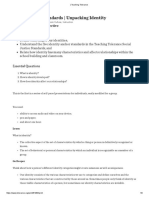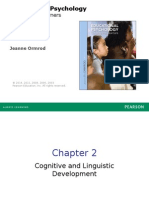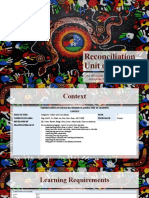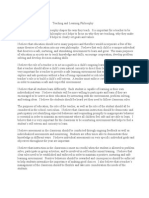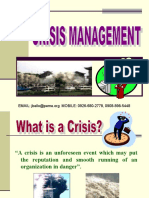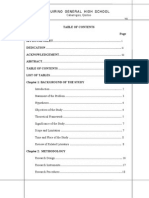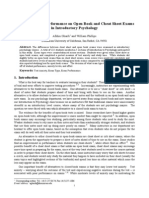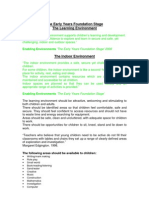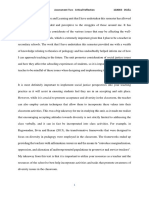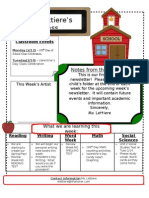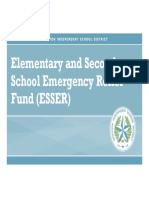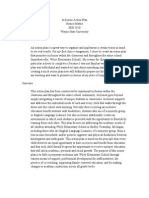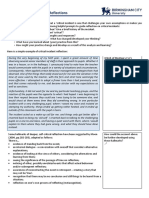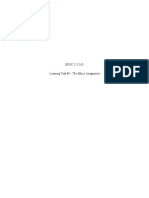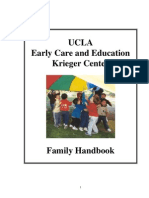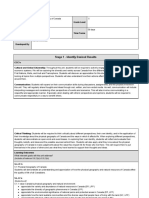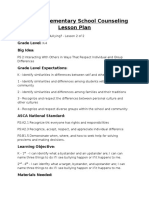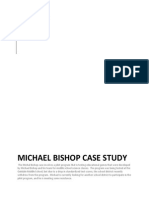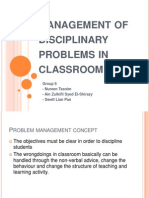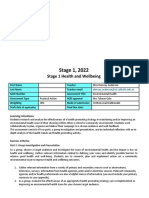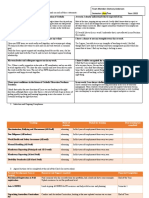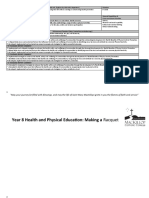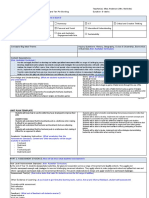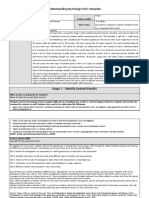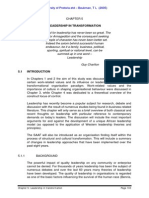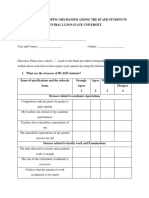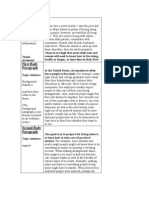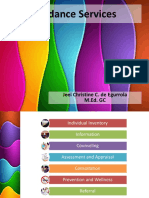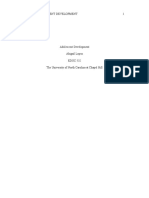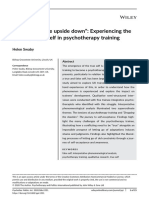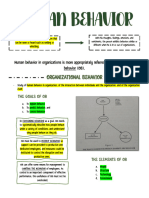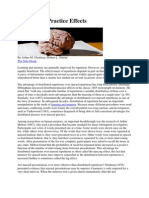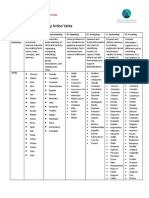Key Wider Educational Issues Connected With Behaviour in Educational Settings
Key Wider Educational Issues Connected With Behaviour in Educational Settings
Uploaded by
api-500494073Copyright:
Available Formats
Key Wider Educational Issues Connected With Behaviour in Educational Settings
Key Wider Educational Issues Connected With Behaviour in Educational Settings
Uploaded by
api-500494073Original Description:
Original Title
Copyright
Available Formats
Share this document
Did you find this document useful?
Is this content inappropriate?
Copyright:
Available Formats
Key Wider Educational Issues Connected With Behaviour in Educational Settings
Key Wider Educational Issues Connected With Behaviour in Educational Settings
Uploaded by
api-500494073Copyright:
Available Formats
EDUC3620 Relationships for Learning Assignment 3
Key wider educational issues connected with
behaviour in educational settings
Introduction
Challenging, disruptive and poor behaviour are always a challenge for educators and
in particular new graduates. Generally, behaviour management is one of the most
challenging aspects for teachers (Hao & Lee, 2016). However, research is proving that not all
disruptive behaviours are caused by a child simply being naughty but can be linked to risk
and protective factors and mental health. This paper will discuss the four domains of risk
factors that can affect children, whilst also linking this to mental health to help explain some
behaviour exhibited in class. Recommendations on how to cope with behaviour, disabilities
and mental health in the classroom will be made based on ethical and effective educational
practices and policies that have presented throughout the duration of the topic.
Student behaviours of concern: risk and protective factors
Student behaviour in schools, home and the community can be affected by what is
known as risk and protective factors. Risk factors are described as being factors that can
negatively affect the child’s behaviour, social interaction or physical development, whilst
protective factors can have a positive influence (Margalit, 2010). There are a range of risk
and protective factors, these include school, family, community and personal factors (Public
Health England, 2015). Risk factors can include children who come from traumatic
backgrounds including abuse, abandonment and loss and these generally arise from the
family. Evidence suggests that children that have experienced some kind of disruption in the
home are at a higher risk of some form of mental health issue and will often display negative
behaviours (Fendrich, Warner & Weissman, 1990). This was something that was evident on
Demcey Anderson 2166970
EDUC3620 Relationships for Learning Assignment 3
placement, as there was a child who was experiencing issues at home. He was extremely
withdrawn from the lesson and didn’t want to participate. He was able to explain this
situation to the teacher and this really highlighted how much a disruption in the home can
affect classroom behaviour.
One example of a risk factor in a school environment is bullying and exclusion or loneliness.
As described by Sharabi, Levi and Margalit, (2012) loneliness is a major cause of distress and
can pose a developmental risk to children who experience prolonged loneliness. This can
have severe negative consequences for behaviour at school, home and in the community.
Sharabi, Levi and Margalit (2012) also explain that this can lead to mental health issues such
as depression. Depression is a major issue within school systems and makes the person feel
hopeless and overwhelmed (Sheppard, 1994). These feelings can often mean a person lacks
motivation and is inattentive, which can also lead to negative behaviours of irritability, anger
and frustration (Jewell & Beyers, 2008). However, these negative behaviours can also be
caused by a range of other reasons as well that relate to the home, community or even the
teacher.
Personal factors are also extremely important when it comes to risk factors. These include
children suffering from some form of disability or learning difficulty or a combination of
both. Remine and Brown (2010) found that even children that suffered from minor physical
disabilities such as poor hearing were at an increased risk of suffering from mental health
issues. The report also found that as the disability or learning difficulty severity increased so
does the risk of suffering from some form of mental health issue (Remine & Brown, 2010).
Sin, Francis and Cook (2010) also stated that around 40% of children with some form of
disability or learning difficulty will suffer from some form of mental health issue. In
comparison only 10% of children who do not suffer from any disability or learning difficulty
Demcey Anderson 2166970
EDUC3620 Relationships for Learning Assignment 3
will suffer from some mental health issue. One of the most common disorders that causes
negative behaviour in the classroom is ADHD (Attention Deficit Hyperactivity Disorder).
Children suffering from ADHD can exhibit extremely disruptive and antisocial behaviour in
the classroom which can sometimes be hard for educators to control (Margolis & Milham,
2016). This can lead to a destructive relationship between the teacher and the child and also
the child and their peers, which can then have a flow on effect to their home and
community life. This is why it is so important to put protective factors into place in schools,
the home and community.
The KidsMatter program along with a range of other programs are used in schools to put
these protective factors into practice (KidsMatter, 2018). Minnard (2002) advocates that
schools that try to implement these types of programs or successful prevention efforts can
often address risk factors on generally more than one level. The Department of Education
also enforces that teachers learn how to recognise, record and report abuse of children
under their care, this is one of the extremely important measures that schools take to
protect children (DECD, 2018). However, schools also use a range of other methods to
protect children. This is why it is of the upmost importance teachers become extremely
familiar with risk and protective factors and how they can affect behaviour in the classroom,
home life and community.
The relevance of mental health when considering behaviour in education settings
Mental health as previously discussed can be a serious consequence of school, home,
community and personal risk factors. This is a particularly important aspect that must be
considered when dealing with children that are described as having challenging, poor or
disruptive behaviour or children that have a disability.
Demcey Anderson 2166970
EDUC3620 Relationships for Learning Assignment 3
Mental health issues are of serious concern and should never be taken lightly, especially
when statistics show that suicide is now the leading cause of death for young people
(Lifeline, 2018). It is also estimated that there are around 65,300 suicide attempts per year
(Lifeline, 2018). These are highly concerning statistics and are generally a consequence of
poor mental health. Mental health implies that a person is able to form positive
relationships, perform in social roles, manage change and can cope with emotions such as
sadness (Bhugra, Till and Sartorius, 2013). Bhugra, Till and Sartorius, (2013) also state that
people with good mental health are also able to manage their behaviour and feel positive
about themselves. This is an important note because as highlighted children with a disability
can often suffer from mental health issues because some see themselves as different to
others, this can lead to negative thoughts about one’s self. These feelings and emotions can
also be highly driven by culture and personality traits (Bhugra, Till and Sartorius, 2013). An
example of children with a disability generally suffering from mental health issues is children
with ADHD, as it is referred to as a psychiatric disorder and affects a person’s ability to
function at school and home, this is then considered poor mental health (Bhugra, Till and
Sartorius, 2013).
Adults, teachers and the community have recently been raising a lot of awareness around
mental health and in particular getting rid of the stigma that surrounds mental health issues.
There are a range of mental health campaigns that are being promoted, these include
programs run by headspace or kids’ helpline that are trying to reduce the stigma and
support people with mental health (Headspace, 2018). The concern is that teachers and
schools are not responding in the best way to support students with mental health
difficulties or students that are at risk. These concerns have triggered many programs to
now be implemented in schools. These include the KidsMatter program which has been
Demcey Anderson 2166970
EDUC3620 Relationships for Learning Assignment 3
designed by health professionals to provide tools, methods and support to schools and
teachers which is shown to be making a positive difference to the lives of Australian children
(KidsMatter, 2018). However, it should also be noted that the way a teacher conducts their
classroom can have a huge impact on helping to manage behaviour and support mental
health.
Recommendations for ethical and effective educational practice and policy
A range of recommendations will be made in light of ethical and effective educational
practice and policy to help manage behaviour and support mental health. When it comes to
policy there are a few that are put in place when it comes to mental health and disability.
The Department of Education policy states that all children with a disability are entitled to
inclusive education, modified programs and support systems to try to ensure that students
learning outcomes and wellbeing are of the upmost importance (Department of Education
(DECD), 2017). From the policy, it is extremely important to create an inclusive classroom
and positive learning environment to support student wellbeing. Pastor and Reuben (2009)
note that schools are now becoming major services for many basic mental health
treatments including behaviour management, assessment and specialised programs. This
links in with what the Department is expecting of schools and teachers in schools. However,
how well schools are implementing this policy is still something that can be debated.
When it comes to pedagogy and teaching strategies, there are two that are extremely
important and are consistently mentioned throughout teacher learning at University. These
strategies involve creating positive relationships with students and creating positive learning
environments for all students. These are both very important to support mental health and
Demcey Anderson 2166970
EDUC3620 Relationships for Learning Assignment 3
manage behaviour, these are also protective factors that can be put into place in schools
(Killen, 2016).
Creating positive relationships with students is one of the most effective ways to engage
students, build resilience and manage behaviour (Duchesne & McMaugh, 2016). Phillips,
Turner and Holt (2011) advocate that children that have supportive and caring relationships
with parents, teachers or caregivers increase resiliency among children and lead to
increased engagement in class and less negative behaviour issues within class. Van Ryzin
(2011) also agreed with Phillips, Turner and Holt (2011) and adds that positive relationships
with students can lead to a range of positive outcomes including higher academic
achievement. There are many ways teachers can go about creating these positive
relationships with their students, these include knowing every student by their name and
knowing relatives and family as well. It is also important that teachers take the time to get
to know the students, what they like or don’t like and what they enjoy doing on the
weekend as this creates some common ground that a teacher can always talk to that
student about. Whilst on teaching placement, it was very clear that the more time you took
to get the know the student the more they would ask questions and seek guidance when
unclear about something. It was also interesting to note how easily a student’s mood could
change when a teacher suddenly talked to the student about something they liked or even
made the content relate to something they love. By making connections between student
interests and the content it encourages students to become more involved with their
learning and have a positive attitude towards learning (Killen, 2016).
Demcey Anderson 2166970
EDUC3620 Relationships for Learning Assignment 3
As the DECD policy outlines it is important that classrooms are safe, supportive and
inclusive. This can be created by ensuring that classrooms are a positive learning
environment that promote inclusion and learning. Patrick, Kaplin and Ryan (2011) state that
“classroom environments play an important role in students' motivation, engagement, and
achievement at school.” There are various ways of creating positive classroom
environments, research has suggested that the two most influential frameworks for creating
these positive environments are achievement goal structured and classroom social climate
structured (Patrick, Kaplin & Ryan, 2011). However, it should be not that both have their
limitations but when implemented together can account for each framework’s weaknesses.
The achievement goal structured framework uses the ideas that student’s need to have
clear expectations, rules and routine to know what is expected of them, it is also the idea
that learning needs to be more than just memorisation but actually applying knowledge and
understanding. This means that tasks set by the teacher need to be meaningful and children
need to see the relevance to real life. Teachers must also be positive and encourage
students to keep meeting challenging goals set for them and strive to achieve their best.
This framework involves a range of complex steps and strategies; however, it caters more
for individuals rather than looking at the class as whole. The classroom social climate
framework corrects this weakness as it encourages collaborative learning and working
together. This also places a high importance on relationships between students, teachers
and peers and making classroom inclusive and supportive (Patrick, Kaplin & Ryan, 2011).
These two frameworks work together extremely well to create a safe, supportive and
inclusive classroom that fosters academic achievement, positive behaviour and is mindful of
mental health and wellbeing.
Demcey Anderson 2166970
EDUC3620 Relationships for Learning Assignment 3
Conclusion
From reviewing the recommendations that have been made it is clear that positive
relationships with students has the greatest impact on student wellbeing, mental health and
behaviour. This was also one the key learning points that was learnt from undertaking this
topic. It is also highly important when teaching to consider why a child may be displaying
poor, negative or disruptive behaviour and that it maybe related to something other than
simply a child being naughty for the sake of it. Another important aspect that was learnt is
that teachers must change their pedagogy and teaching to suit the children in their class and
that this will change from year to year. This highlights why it is incredibly important to
undertake professional development constantly to keep up to date with the latest in
teaching pedagogy as the generations change.
One thing that should be taught more in this topic is about specific disabilities and some
specific signs that would help teachers to possibly recognise disabilities. However, making
sure that teachers didn’t diagnose students, but this would enable teachers to be more
informed about classroom behaviour. It would also enable teachers to give the student the
most effective support or receive the best help, if needed.
For future professional development it would be highly beneficial to build my confidence
and knowledge around special education so that I am able to be the best teacher that I can
be and provide the best support and learning environment to students.
Demcey Anderson 2166970
EDUC3620 Relationships for Learning Assignment 3
Reference List:
Bhugra, D., Till, A., & Sartorius, N. (2013). What is mental health? International Journal of
Social Psychiatry, 59(1), 3-4.
Department of Education (DECD), (2017). Children and Students with disability policy,
retrieved from https://www.education.sa.gov.au/doc/children-and-students-
disability-policy
Department of Education (DECD), (2018). Behaviour management and Strategy, Retrieved
from https://www.education.sa.gov.au/supporting-students/health-e-safety-and-
wellbeing/behaviour-management-and-strategy
Duchesne, S & McMaugh, A. (2016) Educational Psychology for learning and teaching.
Cengage Learning Australia. 3&14, 296-330, 538-580.
Fendrich, M., Warner, V., & Weissman, M. M. (1990). Family risk factors, parental
depression, and psychopathology in offspring. Developmental Psychology, 26(1), 40.
Hao, Y & Lee. K. (2016). Teaching in flipped classrooms: Exploring pre-service teachers'
concerns. Computers in Human Behavior,57, 250-260.
Headspace, (2018) Our campaigns for youth mental health, Retrieved from
https://headspace.org.au/about-us/our-campaigns/
Jewell, J, D., & Beyers, S. (2008). Rearing the sad or mad: Differentiating the family
environments of depressed versus conduct disordered youth. (Report). The
International Journal of Behavioural Consultation and Therapy, 4(1), 82.
KidsMatter. (2018) Successful schools start with healthy minds. Retrieved from
https://www.kidsmatter.edu.au/primary
Killen, R. (2016) Effective teaching strategies (6th ed)
Margalit, M. (2010). Lonely children and adolescents: Self-perceptions, social exclusion and
hope, New York: Springer.
Margolis, A., & Milham, M. (2016). Neural Circuitry underlying three and often co-occurring
childhood disorders: Autism Spectrum Disorder, Attention Deficit/ Hyperactivity Disorder
and Learning disorder. Journal of the American Academy of Child and Adolescent
Psychiatry, 55(10), S328.
Minnard, C. (2002). A strong building: Foundation of protective factors in schools. Children
& Schools, 24(4), 233.
Pastor P. N., Reuben C. A. (2009). Emotional behavioural difficulties and mental health
service contacts of students in special education for non-mental health problems.
Journal of School Health, 79, 82–89.
Patrick, H., Kaplan, A., & Ryan, A, M. (2011). Positive Classroom Motivational Environments:
Convergence between Mastery Goal Structure and Classroom Social Climate. Journal of
Educational Psychology, 103(2), 367-382.
Phillips, M, D., Turner, M, G., & Holt, T, J. (2014). Exploring Resiliency within Schools: An
Investigation of the Effects of Protective Factors. Youth & Society, 46(1), 89-111.
Remine, M., & Brown, P. (2010). Comparison of the prevalence of mental health problems in
deaf and hearing children and adolescents in Australia. Australian and New Zealand
Journal of Psychiatry, 2010, Vol.44(4), P.351-357,44(4), 351-357.
Demcey Anderson 2166970
EDUC3620 Relationships for Learning Assignment 3
Sharabi, A., Levi, U., & Margalit, M. (2012). Children's Loneliness, Sense of Coherence,
Family Climate, and Hope: Developmental Risk and Protective Factors. The Journal of
Psychology, 146(1-2), 61-83
Sheppard, M. (1994). Maternal depression, child care, and the social work role. British
Journal of Social Work, 24, 33-51.
Sin, C., Francis, R., & Cook, C. (2010). Access to and experience of child and adolescent
mental health services: Barriers to children and young people with learning disabilities
and their families. Mental Health Review Journal, 15(1), 20-28.
Lifeline. (2018) Statistics on Suicide in Australia. Lifeline.org. Retrieved from
https://www.lifeline.org.au/about-lifeline/lifeline-information/statistics-on-suicide-in-
australia
Van Ryzin, M, J. (2011). Protective Factors at School: Reciprocal Effects among Adolescents'
Perceptions of the School Environment, Engagement in Learning, and Hope. Journal of
Youth and Adolescence, 40(12), 1568-1580.
Demcey Anderson 2166970
You might also like
- KenGen ICT PolicyDocument24 pagesKenGen ICT PolicyMinani Jean Baptiste100% (1)
- Mtss Action ResearchDocument52 pagesMtss Action Researchapi-351315379100% (1)
- Self-Assessment and Professional Development Plan PDFDocument2 pagesSelf-Assessment and Professional Development Plan PDFSarah LaytonNo ratings yet
- Social Justice Standards - Unpacking IdentityDocument9 pagesSocial Justice Standards - Unpacking IdentityAmLensNewsNo ratings yet
- Ict PolicyDocument11 pagesIct Policyapi-286241363No ratings yet
- Edu-690 Action Research PaperDocument27 pagesEdu-690 Action Research Paperapi-240639978No ratings yet
- Exercise and The Brain EssayDocument5 pagesExercise and The Brain Essayapi-317879960No ratings yet
- Educational PhilosophyDocument3 pagesEducational Philosophyapi-270231720No ratings yet
- Chapter 2 Cognition and LinguisticDocument33 pagesChapter 2 Cognition and LinguisticMichael CottenNo ratings yet
- Reconciliation Unit of LearningDocument18 pagesReconciliation Unit of Learningapi-500494073No ratings yet
- Fashion Therapy Term Project PDFDocument74 pagesFashion Therapy Term Project PDFStay HomeNo ratings yet
- Literacy Development PaperDocument6 pagesLiteracy Development Paperapi-488912445No ratings yet
- The Importance of Adhering To A Professional Code of EthicsDocument2 pagesThe Importance of Adhering To A Professional Code of EthicsAnacleto59No ratings yet
- Technology in The Classroom Research PaperDocument10 pagesTechnology in The Classroom Research Paperapi-27024303650% (2)
- Etec 532 - Cip Annotated Bibliography and Literature ReviewDocument24 pagesEtec 532 - Cip Annotated Bibliography and Literature Reviewapi-454370498No ratings yet
- Long Range PlanningDocument7 pagesLong Range Planningapi-529095602No ratings yet
- L21 Long Range PlanningDocument7 pagesL21 Long Range Planningapi-3820619No ratings yet
- Teaching and Learning PhilosophyDocument2 pagesTeaching and Learning PhilosophyNicole WalstromNo ratings yet
- Competency Framework For Education Assistants (Special Needs) FINAL 2008 PDFDocument41 pagesCompetency Framework For Education Assistants (Special Needs) FINAL 2008 PDFtherealpristinaNo ratings yet
- Crisis Management1Document59 pagesCrisis Management1Infrastructure Development ServiceNo ratings yet
- Parent SST HandoutDocument4 pagesParent SST Handoutapi-239565419No ratings yet
- Table of ContentsDocument4 pagesTable of ContentsKristine PearlNo ratings yet
- Open Book ExamsDocument4 pagesOpen Book ExamsshoaybkhanNo ratings yet
- Diversity 1Document8 pagesDiversity 1api-553452414No ratings yet
- Enable Environments - Organizare Sala de GrupaDocument18 pagesEnable Environments - Organizare Sala de Grupaoanadragan100% (2)
- Work Based Learning Lesson PlanDocument7 pagesWork Based Learning Lesson PlanAngela BarrettNo ratings yet
- Gifted BrochureDocument2 pagesGifted Brochureapi-261349030No ratings yet
- Critical Reflection - Diversity Social Justice and LearningDocument4 pagesCritical Reflection - Diversity Social Justice and Learningapi-486643692No ratings yet
- Sample Transition Iep FormDocument28 pagesSample Transition Iep Formapi-241173571No ratings yet
- HSE Training Record: Si - No Name of Workman Designation SignatureDocument1 pageHSE Training Record: Si - No Name of Workman Designation SignatureSRR HSE Department, Sandvik Project,No ratings yet
- Newsletter TemplateDocument2 pagesNewsletter TemplateValentinaManninoNo ratings yet
- Australian Professional Teaching StandardsDocument6 pagesAustralian Professional Teaching Standardsapi-356862575No ratings yet
- HISD Presentation Copy of Elementary and Secondary School Emergency Relief FundDocument54 pagesHISD Presentation Copy of Elementary and Secondary School Emergency Relief FundHouston ChronicleNo ratings yet
- Inclusion Action PlanDocument5 pagesInclusion Action PlanBianca MattiaNo ratings yet
- Culturally Responsive Classroom MGMT Strat2Document10 pagesCulturally Responsive Classroom MGMT Strat2api-300877581No ratings yet
- Sammy ExceptionalityDocument8 pagesSammy ExceptionalityShacara MillingtonNo ratings yet
- Educ4820 Inquiry Research Reflection and PlanningDocument5 pagesEduc4820 Inquiry Research Reflection and Planningapi-481397791No ratings yet
- Example+Critical+Incident+Reflection+ +handoutDocument2 pagesExample+Critical+Incident+Reflection+ +handoutTrixine BrozasNo ratings yet
- Tech Integration Checklist ResourceDocument3 pagesTech Integration Checklist Resourcetipp3449No ratings yet
- Positive Behavioral Interventions and SupportsDocument15 pagesPositive Behavioral Interventions and Supportsapi-312968514No ratings yet
- Key Elements For An Effective Participatory Environmental MonitoringDocument10 pagesKey Elements For An Effective Participatory Environmental MonitoringEnvironmental Governance Programme (EGP) for Sustainable Natural Resource ManagementNo ratings yet
- ICT PolicyDocument10 pagesICT Policystcronans100% (1)
- Running Head: Individualized Education Program 1Document5 pagesRunning Head: Individualized Education Program 1api-532715918No ratings yet
- Educ 525 lt2Document6 pagesEduc 525 lt2api-445253818No ratings yet
- Classroom ManagementDocument12 pagesClassroom ManagementMichael King75% (4)
- Krieger Family HandbookDocument62 pagesKrieger Family Handbooksweetkim0515No ratings yet
- Multicultural Lesson PlanDocument4 pagesMulticultural Lesson Planapi-534303487No ratings yet
- Curriculum and Professional Development Implementation Plan For The 2009-2010 Academic School YearDocument60 pagesCurriculum and Professional Development Implementation Plan For The 2009-2010 Academic School YearHob151219!No ratings yet
- Differentiation Portfolio Michael FerrisDocument11 pagesDifferentiation Portfolio Michael Ferrisapi-263403037No ratings yet
- Reimagining and Empowering The Design of Projects A ProJect - Based Learning Goals FrameworkDocument10 pagesReimagining and Empowering The Design of Projects A ProJect - Based Learning Goals FrameworkTote Cifuentes AmigoNo ratings yet
- Msed Portfolio Section ThreeDocument19 pagesMsed Portfolio Section Threeapi-519219936No ratings yet
- Social - Physical Geography of Canada Unit PlanDocument42 pagesSocial - Physical Geography of Canada Unit Planapi-336712848No ratings yet
- Peculiar Elementary School Counseling Lesson Plan: Lesson Title Grade Level Big IdeaDocument3 pagesPeculiar Elementary School Counseling Lesson Plan: Lesson Title Grade Level Big Ideaapi-227714293No ratings yet
- MLSS Supplemental Guide For Student Assistance Team 2019Document16 pagesMLSS Supplemental Guide For Student Assistance Team 2019Ann CannonNo ratings yet
- Theories basedInclusiveEducationPractices PDFDocument9 pagesTheories basedInclusiveEducationPractices PDFCarolinaNo ratings yet
- CSCP PortfolioDocument67 pagesCSCP Portfolioapi-548101945No ratings yet
- Section Three WeeblyDocument127 pagesSection Three Weeblyapi-520295048No ratings yet
- Michael Bishop Case AnalysisDocument6 pagesMichael Bishop Case Analysisapi-254598695No ratings yet
- Workplace ViolenceDocument27 pagesWorkplace Violencealit2No ratings yet
- Management of Disciplinary ClassroomDocument18 pagesManagement of Disciplinary ClassroomNajihah NajmuddinNo ratings yet
- Learning Contract ExampleDocument2 pagesLearning Contract Exampleapi-287621333100% (1)
- Personal Reflection Designing TeachingDocument6 pagesPersonal Reflection Designing Teachingapi-380738892No ratings yet
- Digital Commons at CSUMB Digital Commons at CSUMBDocument44 pagesDigital Commons at CSUMB Digital Commons at CSUMBAmosGArcones, Dalia Pelin V.No ratings yet
- Professional Development Activities LogDocument13 pagesProfessional Development Activities Logapi-500494073No ratings yet
- Environmental Health Stage 1Document3 pagesEnvironmental Health Stage 1api-500494073No ratings yet
- Netball Academy - Semester 2 Unit OverviewDocument18 pagesNetball Academy - Semester 2 Unit Overviewapi-500494073No ratings yet
- Netball-Lesson-1 2 1Document3 pagesNetball-Lesson-1 2 1api-500494073No ratings yet
- Partnership Check inDocument2 pagesPartnership Check inapi-500494073No ratings yet
- Elective Handbook 2022Document15 pagesElective Handbook 2022api-500494073No ratings yet
- Fraction Summative TestDocument8 pagesFraction Summative Testapi-500494073No ratings yet
- Year 8 Hpe t3 Workbooklet 2022Document20 pagesYear 8 Hpe t3 Workbooklet 2022api-500494073No ratings yet
- 8hpe Health Promotion Assessment - Cover Sheet and TaskDocument7 pages8hpe Health Promotion Assessment - Cover Sheet and Taskapi-500494073No ratings yet
- 8 HpeDocument7 pages8 Hpeapi-500494073No ratings yet
- 2022 Risk Assessment For Hpe Classes Park Cross Country and or 16 Mile WalksDocument9 pages2022 Risk Assessment For Hpe Classes Park Cross Country and or 16 Mile Walksapi-500494073No ratings yet
- Assignment 1 Tiered Lesson Template DemceyDocument21 pagesAssignment 1 Tiered Lesson Template Demceyapi-500494073No ratings yet
- Parental Consent Form NetballDocument2 pagesParental Consent Form Netballapi-500494073No ratings yet
- Year 10 Pe Unit PlanDocument15 pagesYear 10 Pe Unit Planapi-500494073No ratings yet
- Assignment 3 Demcey AndersonDocument19 pagesAssignment 3 Demcey Andersonapi-500494073No ratings yet
- Assignment 2 Unit PlanDocument20 pagesAssignment 2 Unit Planapi-500494073No ratings yet
- Integrated Numeracy and ICT Lesson PlanDocument8 pagesIntegrated Numeracy and ICT Lesson Planapi-500494073No ratings yet
- Module1 ACTIVITYDocument3 pagesModule1 ACTIVITYdylyn jane gallegoNo ratings yet
- Leadership in TransformationDocument65 pagesLeadership in TransformationGhansham PanwarNo ratings yet
- Background Guide Who WismunDocument3 pagesBackground Guide Who WismunVedant DasNo ratings yet
- Executive FunctionsDocument10 pagesExecutive FunctionsDesiree NoriceNo ratings yet
- Educ 3Document2 pagesEduc 3Keseya Castillo TorresNo ratings yet
- Literature Review On Motivation and Job SatisfactionDocument5 pagesLiterature Review On Motivation and Job SatisfactionaflsvagfbNo ratings yet
- Alcohol AbuseDocument14 pagesAlcohol AbuseAbdul QuyyumNo ratings yet
- Ingrid Bergman: TMA Talent Assessment D Drriivveess RreeppoorrttDocument9 pagesIngrid Bergman: TMA Talent Assessment D Drriivveess RreeppoorrttSajjad SahabiNo ratings yet
- Polyamory and FeelingsDocument25 pagesPolyamory and FeelingsENo ratings yet
- Models in The Study of Abnormal BehaviorDocument34 pagesModels in The Study of Abnormal BehaviorLuas PelegriniNo ratings yet
- Cur Map P.E 1Document11 pagesCur Map P.E 1johnreyestabillo0328No ratings yet
- Ob Case Study 1Document6 pagesOb Case Study 1Irfan NafriNo ratings yet
- NCM109 Rle - ReviewerDocument2 pagesNCM109 Rle - ReviewerEarly Jane RamirezNo ratings yet
- Career Options For Mass Communication Students in NigeriaDocument2 pagesCareer Options For Mass Communication Students in NigeriaMahmud Abdullahi SarkiNo ratings yet
- Stressors and Coping Mechanism Among The Bcaed Student in Central Luzon State UniversityDocument3 pagesStressors and Coping Mechanism Among The Bcaed Student in Central Luzon State UniversityEljhon VerganosNo ratings yet
- Internet Addiction Test: Dr. Kimberly S. YoungDocument11 pagesInternet Addiction Test: Dr. Kimberly S. Youngvinita singh0% (1)
- Exercise For SQ3RDocument6 pagesExercise For SQ3RNajmi TajudinNo ratings yet
- Educational Psychology HudDocument48 pagesEducational Psychology HudKetheesaran LingamNo ratings yet
- Guidance Services 55b0da7bcf740Document67 pagesGuidance Services 55b0da7bcf740Phil DaveNo ratings yet
- The Importance of Establishing and Building Trust in Your Team and How To Do ItDocument5 pagesThe Importance of Establishing and Building Trust in Your Team and How To Do ItRadu BadalanNo ratings yet
- Adolescent InterviewDocument9 pagesAdolescent Interviewapi-532448305No ratings yet
- Creating A Healthy Balance: Technology AddictionDocument4 pagesCreating A Healthy Balance: Technology AddictionAnurag VishwakarmaNo ratings yet
- 2.-Topic-2-Culture (Autosaved)Document88 pages2.-Topic-2-Culture (Autosaved)maybel dela cruzNo ratings yet
- Swaby, Helen (2020) - Learning To 'Live Upside Down' - Experiencing The True and False Self in Psychotherapy TrainingDocument15 pagesSwaby, Helen (2020) - Learning To 'Live Upside Down' - Experiencing The True and False Self in Psychotherapy TrainingPaul CNo ratings yet
- CCB LeadershipDocument24 pagesCCB LeadershipNestor BalboaNo ratings yet
- Chapter 1 Overview of Human Behavior in OrganizationsDocument5 pagesChapter 1 Overview of Human Behavior in OrganizationsLovenia M. FerrerNo ratings yet
- Distributed Practice EffectsDocument6 pagesDistributed Practice EffectsDina NadhirahNo ratings yet
- Blooms TaxonomyDocument1 pageBlooms TaxonomyAngel FranciscoNo ratings yet



